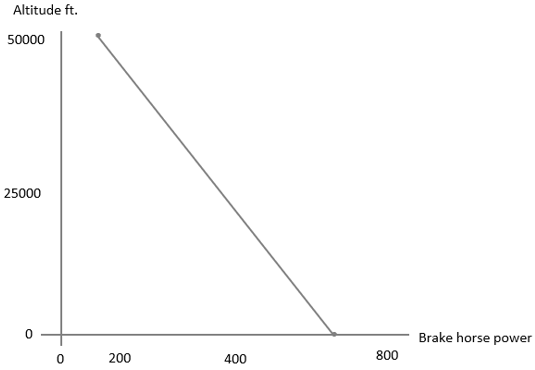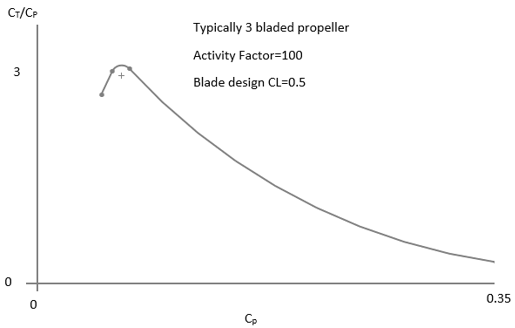This set of Aircraft Design online quiz focuses on “Propulsion – Piston-Engine and Turboprop Performance”.
1. Mass flow rate will be affected by __________
a) altitude
b) weight of the aileron
c) induced drag only
d) longerons weight
View Answer
Explanation: Typically, Mass flow rate can be expressed as follows: mass flow rate = density*Area*Velocity. Density is function of altitude. It depends on the altitude and changes as per the international standard atmosphere. Hence, if density varies then, the mass flow rate will also vary. Hence, we can say that the mass flow rate is affected by the altitude.
2. A piston engine has bhp of 600 at sea level. Now, if engine is operating at an altitude where density ratio is 0.816 then, find the value bhp at that altitude.
a) 37
b) 89
c) 100
d) 289
View Answer
Explanation: Given, sea level bhp, p1 = 600, density ratio d = 0.816
Now, bhp at an altitude = p1*(d – ((1-d)/7.55))
= 600*(0.814-((1-0.814)/7.55))
= 600*(0.814-(0.1836/7.55)
= 600*0.0616 = 37.
3. Supercharger is used to improve __________
a) intake manifold pressure
b) outlet pressure
c) to increase charging capacity of an electric charger
d) expansion of exhaust velocity
View Answer
Explanation: Supercharger is used to increase intake manifold pressure. We can increase manifold pressure by small amount by using forward facing air intake scoop. Supercharger or turbocharger is used to increase manifold pressure by large amounts.
4. Following diagram represents ________

a) bhp variation with altitude
b) drag polar
c) lift curve
d) power required vs thrust required
View Answer
Explanation: Typical bhp variation with altitude is presented in this diagram. Above diagram is illustrating the relationship between bhp and the altitude. Drag polar is used to provide information about drag characteristics. Lift curve is used to provide relationship between lift and angle of attack.
5. If a propeller has speed of 600 rpm and diameter of 1.2m and velocity of 10m/s. Find advance ratio.
a) 0.83
b) 0.39
c) 0.289
d) 0.1
View Answer
Explanation: Advance ratio = velocity*60 / (rpm*diameter)
= 10*60 / (600*1.2) = 0.83.
6. If a propeller has bhp of 700 and diameter as 1.2 ft. and rotating with 20 rps then, determine power coefficient. Consider sea level density.
a) 15.8
b) 1.8
c) 30.2
d) 40
View Answer
Explanation: Power coefficient = 550*bhp / (density*diameter5*rps3)
= 550*700 / (1.225*1.25*203) = 15.8.
7. Determine the required thrust coefficient to produce thrust of 1000N. Given diameter is 1.2m and n=22 rps.
a) 0.813
b) 0.1
c) 0.32
d) 0.489
View Answer
Explanation: Thrust coefficient = Thrust / (density*diameter4*rps2) = 1000 / (1.225*1.24*222) = 0.813.
8. What should be the value of speed power coefficient if velocity of propeller is 12 unit and power is 100 unit? Given rps is 25.
a) 1.372
b) 2.35
c) 8.97
d) 9.79
View Answer
Explanation: Speed power coefficient = Velocity*(density / power*rps2)0.2 = 12*(1.225/100*25*25)0.2 = 12*0.1144 = 1.372.
9. Determine the propeller efficiency if propeller velocity is 300ft/s and thrust of 1320 lb. Given bhp is 800.
a) 90%
b) 0.03%
c) 0.895%
d) 0.09%
View Answer
Explanation: Propeller efficiency = (thrust*velocity) / (bhp*550) = 1320*300/ (550*800) = 0.9 = 0.9*100 % = 90%.
10. Determine thrust of propeller if propeller efficiency is 85%. Propeller is assumed to be operated with 1200 bhp and 350ft/s of velocity.
a) 1602.85 lb
b) 12kN
c) 16789lb
d) 8902lb
View Answer
Explanation: Thrust = 550*bhp*propeller efficiency/velocity = 550*1200*0.85/350 = 1602.85 lb of force.
11. If slip function of propeller is 0.075 and diameter is 20 ft. then, determine the velocity of propeller. Given n = 25 rps.
a) 37.5 ft/s
b) 40ft/min
c) 128ft
d) 300ft/s2
View Answer
Explanation: Velocity = slip function*diameter*rps = 0.075*20*25 = 37.5 ft/s.
12. A propeller is rotating with 20 rps has diameter of 2.5m. Calculate thrust produced by the propeller if thrust coefficient is 0.01.
a) 191.40N
b) 2000kN
c) 1.2MN
d) 190KN
View Answer
Explanation: Thrust = Thrust coefficient*density*diameter4*rps2 = 0.01*1.225*2.54*202 = 191.40 N.
13. Following diagram represents __________

a) static propeller thrust
b) lift augmentation
c) thrust reversal
d) vortex generator
View Answer
Explanation: Above diagram is representing typical static propeller thrust concept. Lift augmentation is used to increase the amount of lift produced. Thrust augmentation is used to increase the amount of thrust produced by engine. Thrust augmentation is used to increase thrust during short takeoff distance.
14. Inflow ratio is defined as __________
a) total inflow velocity to tip speed
b) total lift by rotor to the total drag
c) drag to lift ratio
d) propulsive efficiency
View Answer
Explanation: Inflow ratio can be defined as the ratio of total inflow velocity to the tip speed. Drag to lift ratio is inverse of Aerodynamic efficiency. Higher Aerodynamic efficiency indicates that the aircraft will have higher lift.
15. Activity factor is a measure of _________
a) the amount of power which is being absorbed by propeller
b) power generated by propeller
c) lift induced drag
d) parasite drag
View Answer
Explanation: How much power is being absorbed by propeller can be measured by using activity factor. Activity factor varies from 90-200. A typical large turboprop will have an activity factor of 140. Lighter aircraft can have activity factor as 100 typically.
Sanfoundry Global Education & Learning Series – Aircraft Design.
To practice all areas of Aircraft Design for online Quizzes, here is complete set of 1000+ Multiple Choice Questions and Answers.
If you find a mistake in question / option / answer, kindly take a screenshot and email to [email protected]
- Check Aircraft Design Books
- Check Aeronautical Engineering Books
- Check Aerospace Engineering Books
- Apply for Aerospace Engineering Internship
- Practice Aeronautical Engineering MCQs
